A Tale To Tell
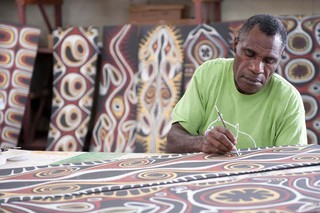
Asia Pacific Triennial of Contemporary Art APT7 Gallery of Modern Art Papua New Guinea artists working on APT7 artwork / View full image
The telling of stories is important in Papua New Guinea. It is the way that knowledge is passed on, a time to relax, and an important means of connecting with others.
This story is about the Gallery’s latest project — a tale that began in July 2011 when Michael O’Sullivan and myself, and guest co-curator Martin Fowler travelled to New Britain and the East Sepik River in Papua New Guinea to conduct research for ‘The 7th Asia Pacific Triennial of Contemporary Art‘ (APT7).
The National Mask Festival in Kokopo, East New Britain was our first stop. Here, the spirits arrived in an awesome procession, amidst kundu drumming, singing and chanting. Immersed in this soundscape, intricately patterned masks were spectacularly animated, creating an emotionally charged experience for everyone present.
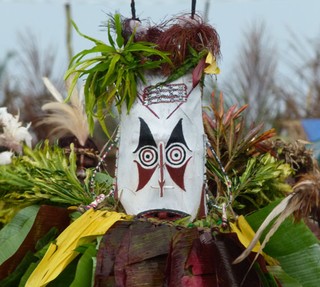
Bruno Akau and Alfred Sapu, Pileo island, West New Britain, Papua New Guinea Tabuan Kamut Mut 2011 / Photograph: © QAGOMA / View full image
Attendance at the festival provided important opportunities for our team to engage in long discussions with artists and community leaders about their work and its significance within their lives. Such exchanges resulted in the acquisition of masks from five different cultural groups from across New Britain and the Sepik River. These objects, which will be part of a major presentation in the Gallery of Modern Art (GOMA) for APT7, demonstrate the continuing vibrancy of works created to be used in customary contexts in Papua New Guinea.
The Sepik River region is known around the world for producing some of the most dynamic products of the human imagination. Yet most literature on this art positions it in the context of ‘authentic traditions’ and a distant past. Our experience as we travelled from the Prince Alexander mountains down to the Sepik river revealed the opposite, as groups of artists from Abelam, Kwoma, Arapesh and Iatmul cultural groups demonstrated the continuing relevance of their respective traditions and the different ways in which they evolve in response to new experiences and audiences.
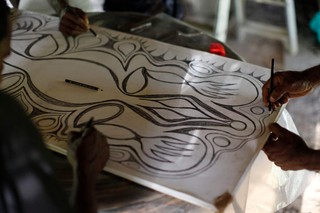
Kwoma artists working on drawing by Nelson Makamoi, Ilahita, painting workshop, July 2011 | Photograph: © Richard Kendall / View full image
One example is the painting workshop conducted in the Arapesh village of Ilahita. This event provided opportunities to talk with a wide range of artists about their work, its relationship to their different cultures as well as to see how they responded to using introduced materials such as canvas, plywood and synthetic polymer paints.
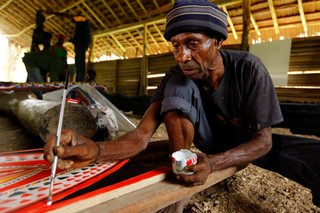
Waikua Nera, Ilahita painting workshop, July 2011 | Photograph: © Richard Kendall / View full image
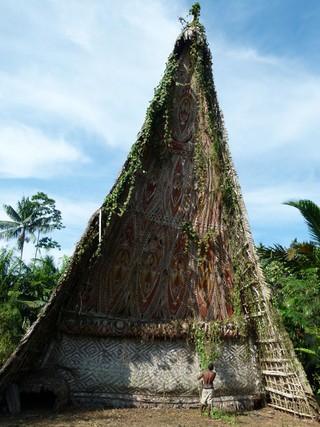
Waikua Nera, Korumbo (Spirit house), 2006, Brikiti village, Papua New Guinea / Photograph: © QAGOMA / View full image
Following this workshop, we moved from the village of Ilahita, through Maprik and down the river to Ambunti, Tongwinjamb and Yessan, where there were opportunities to view spectacular ceremonial men’s houses and Koromb (Spirit house) created from locally sourced, ephemeral materials by artists involved in the workshop. The extraordinary presence of these structures and the art created for them provided the impetus to propose two major commissions that responded to the ongoing tradition of Sepik men’s houses, for APT7.
A return visit to the region in November 2011 resulted in the invitation of 10 artists to work on these commissions. Three Abelam artists — Waikua Nera, Nikit Kiawaul and Kano Loctai, were invited to create a new work responding to the Korumbo (Spirit house) created in their village of Brikiti — Apengai. Seven Kwoma artists were also invited — Anton Waiawas, Rex Maukos, Kevin Apsepa, Simon Goiyap, Terry Pakiey, Nelson Makamoi and Jamie Jimok — to create new work based on the spectacular painting and carving found in their Koromb (Spirit house). These are the equivalent of a parliament house for the Kwoma people. They use these structures as places to come together, in the presence of the spirits, to debate and make important community decisions.

Simon Goiyap | b.1973 | Kwoma people, Mino village, East Sepik River, Papua New Guinea | Koromb (Spirit house) | Natural pigments on pangal and carved garamut with sago leaf thatching / View full image
It was important for us that the creation of work for these commissions take place in Brisbane, Queensland so that the artists had the opportunity to view the spaces in which their work would reside, to meet other artists and see a wide range of other cultural materials. The artists left their villages in late January, many travelling outside of the Sepik region for the first time.
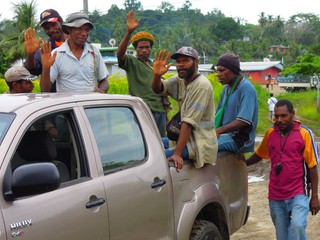
Selected Kwoma artists from left: Jamie Jimok, Simon Goiyap, Anton Waiawas, Terry Pakiey, Kevin Apsepa, Rex Maukos and Nelson Makamoi, Maprik, November 2011 / Photograph: Martin Fowler / View full image
All of the artists settled into life in Brisbane very quickly, eager to work with Gallery teams to fine tune drawings and plans relating to the final installation of their work
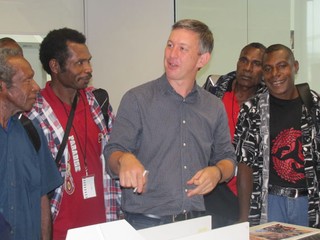
Kwoma artists working with Gallery Exhibitions team. From left: Anton Waiawas, Simon Goiyap, Michael O’Sullivan, Rex Maukos and Nelson Makamoi / Photograph: © QAGOMA / View full image
Within a week, work had begun in earnest and with each visit to the artists there was a wealth of amazing painting and carving to view.
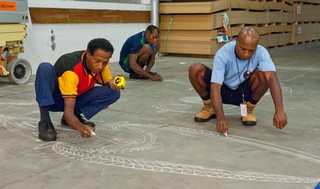
Artists from Papua New Guinea prepare a layout for the construction of a representation of an Abelam House, to be constructed as part of the 7th Asia Pacific Triennial at the Queensland Art Gallery, Brisbane in 2012 / View full image
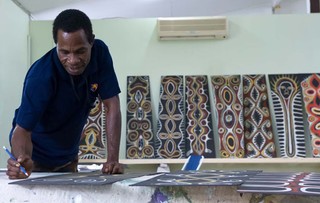
Asia Pacific Triennial of Contemporary Art APT7 Gallery of Modern Art Papua New Guinea artists working on APT7 artwork / View full image
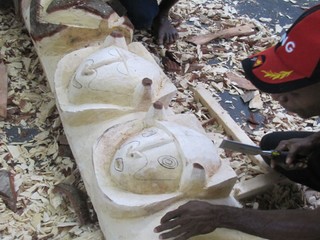
Abelam artist Kano Locatai carving lintel for Koromb (Spirit house), February 2012 / Photograph: © QAGOMA / View full image
Visits to the workshop have been made by local Aboriginal community leaders, the PNG Consul General, Brisbane and project sponsors Kramer Ausenco. Attending the latter event was Kramer Ausenco Chairman Sir Rabbie Namaliu (ex Prime Minister of Papua New Guinea) and, a big hit, Ambassador Mal Meninga (Australian former rugby league test captain and current coach of Queensland’s State of Origin team).
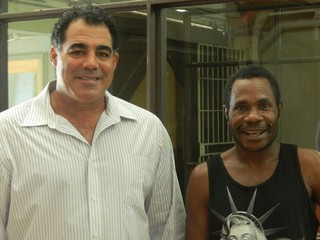
Kramer Ausenco Ambassador Mal Meninga with Kwoma artist Terry Pakiey, February 2012 / Photograph: © QAGOM / View full image
A month into the project, and the Abelam artists are now completing the final painted panels for their majestic house front. The carving is finished, and cane and palm leaf fronds are at the ready to weave the Korumbo (Spirit house) cap, a small woven basket shaped cap at the apex of the triangular face which protects the house and the spirits inhabiting it. A few final pieces and decorative bilas, such as bilums, flowers, and seeds will be shipped to Brisbane and installed by the artists when they return to work with Gallery workshop and installation staff to erect the Haus in November.
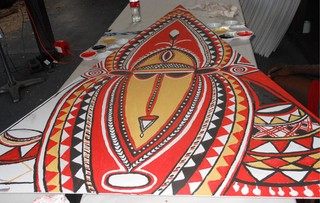
Painting for Korumbo (Spirit house), February 2012 | Photograph: Kevin Apsepa / Photograph: © QAGOMA / View full image
The Kwoma team have another month on site to finish carving and painting. Visits to the studio involve much storytelling as each of the artists speaks about the designs they are creating. Despite great differences in their cultures, an important subject for both groups is their relationship to place — the importance of nature, its transformation into complex cosmologies and the histories of change.
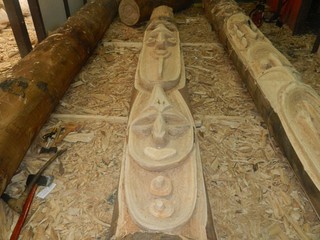
Koromb (Spirit house) post carvings by Simon Goiyap (left), and Nelson Makamoi and Jamie Jimok (right), February 2012 / Photograph: Simon Goiyap / View full image
The capacity for change is exemplified in these works, adaptability demonstrated through the incorporation of new ideas and materials. That said, the works are powerfully tied to strong cultures. These works stand apart, as a reminder that while we live in an environment of transition and global exchange, the ways in which we communicate our ties to place, history and each other are unique.
The village of Tongwinjamb, has now also become my place, and Kwoma my tok ples — the Kwoma artists formally making me their sister at a special ceremony on Sunday 4 March. I am sure that there will be many more stories to tell as relationships between communities in Papua New Guinea and the Gallery continue to develop. Looking back over the twenty year history of APT, the artists supported and the strong ties that have been created, I am sure that these will be positive ones.

